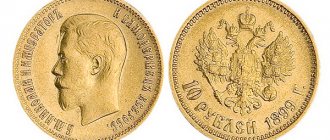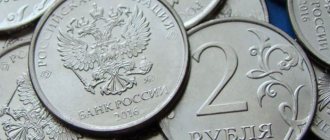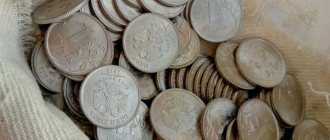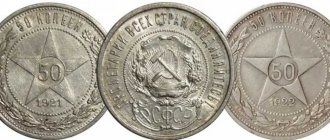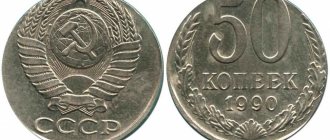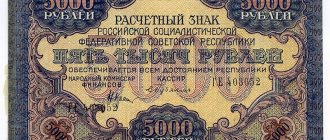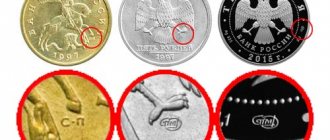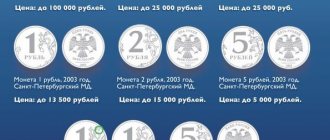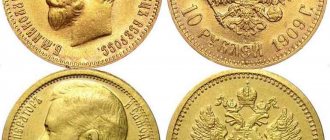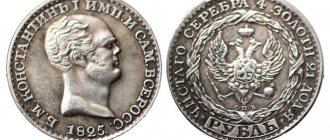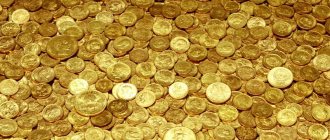Author: Sergei
30 October 2021 21:09
Tags: Numismatics USSR coins
23754
11
Soviet coins sell for huge sums of money. The most inexpensive but rare coin with a face value of 20 kopecks is estimated at 50,000 rubles. An exclusive fifty-kopeck piece from '29 was sold at auction for 10 million rubles. Modern numismatists are always chasing rare coins. They do not ask about the price, they simply buy the most expensive coins of the USSR and other times. The main thing for them is to complement their collection.
0
See all photos in the gallery
Commemorative and anniversary copies of the Soviet era
Commemorative and commemorative coins from the USSR period do not have any special numismatic value. Their minting took place from 1965 to 1991. As a rule, they were dedicated to the anniversaries of famous personalities and memorable events. They were produced in small quantities, as they were usually intended for collectors. Of course, the anniversary rubles of this period are simply amazing in their quantity. It is unlikely that anyone will be able to list them all. Therefore, let's look at some of the most interesting options:
- 1 “wooden”, which depicts a portrait of V.I. Lenin. Its minting took place in 1978 in honor of the hundredth anniversary of the birth of the leader of the proletariat. The cost of money reaches 25 thousand rubles.
- 1 “wooden” 1978 with the image of the Moscow Kremlin. Costs about 15,000 rubles.
- Platinum anniversary rubles from the late 70s, dedicated to the 1980 Olympics. The price for them is about 40 thousand rubles. Also during this period, 100 rubles were dedicated to the Olympics. gold. Their price is slightly lower - up to 30,000.
- Palladium coins minted between 1988 and 1991. Their cost depends on how well they are preserved and ranges from 10-27 thousand rubles. However, the demand for such money is not high, since the attention of numismatists and collectors is attracted by more valuable options.
Types of stamps
Popular varieties among collectors are 1 ruble 1997 MMD with a wide edge and 1 ruble 1998 MMD with a wide edge. Using the example of 1 ruble 1997 MMD, the differences in the design of stamps are as follows:
| narrow edging | wide edging |
A particularly interesting variant of the varieties are cases of stamp confusion, which are extremely rare in this period, but I simply cannot help but mention them. Such varieties appear in cases where one of the stamps from a different denomination is used for minting coins. For example, the obverse stamp is 5 or 10 kopecks when minting 50 kopeck coins.
50 kopecks 2007 M, minted using the obverse stamp 5 kopecks (sputnik75)
50 kopecks 2013 M, minted using the reverse stamp 10 kopecks (Albanian)
Numismatics of the 20s
In the 20s The Soviet monetary system was in its infancy. And not only this. The issue of coins was also not established in the young country due to the dominance of paper money (credit notes, bank notes, ration cards, etc.). The issue of change coins was a primary task, so the opening of the mint illuminated the state with prospects in 1921. It was the Petrograd Mint. At the same time, the rarest coins of the USSR appeared.
1 ruble 1921 - 1922
It seems to be the same silver coin with the same denomination, minted according to the same pattern, but the cost is completely different. A ruble from 1921 costs 1,700 rubles, but a ruble from 1922 will cost 9,000 rubles. Their occurrence is approximately the same, and the difference in cost is due to historical conditions. The Petrograd Mint experienced a crisis in all its manifestations in 1922 (we remember where the silver reserves went in 1905-1920). It was the crisis that led to the redistribution of power at the mint. When Arthur Hartmann was replaced by Pyotr Latyshev, the two-million circulation of silver rubles with Hartmann’s initials was supplemented by an issue with the initials “PL”.
Other coins of 1921 - 1922 are not of particular value. 50 kopecks cost 450 rubles, the rest – 100 rubles. Only 50 kopecks from 1922 with a smooth edge are valued at 18,000 rubles.
Characteristic.
The coin with a diameter of 3.35 cm is made of pure silver (900 standard). “Workers of all countries, unite!” - reads the inscription on the reverse. Moreover, the comma is placed in the center on some copies, and adjacent to the word “countries” on others. In the center is the coat of arms of the RSFSR, below is the abbreviation S.S.S.R. On the obverse, as usual, there is a star and a denomination, enclosed in a ring of oak and laurel branches. Below is the word “RUBLE”. Rubles with the initials “AG” and “PL” from 1922 cost 9,000 rubles. The initials can be seen on the edge. Some ruble coins are made from other materials, but these are exceptional cases and are valued individually.
Possible fakes
Expensive USSR coins did not go unnoticed by scammers. After all, their cost is quite high, so now fakes are not uncommon on the numismatic market. Moreover, they are made so skillfully that only a specialist can distinguish the original from the fake. Therefore, the authenticity of a coin cannot be determined from a photograph, because all its features will not be visible on it. Therefore, if you do not understand this matter, then buying an expensive coin is not recommended. If you find a coin, you can seek advice from an experienced numismatist who will determine its authenticity.
Thus, thanks to rare coins of the USSR, you can even study the history of the country. After all, each of them was created under certain specific circumstances. However, if you have a rare coin in your hands, there is no need to rush to sell it. After all, there are scammers who want to buy it much cheaper, especially via the Internet. Therefore, it is better to first consult with someone knowledgeable in this area.
Coins without mint mark
At the moment, only 3 such coins are known - 5 kopecks 2002, 5 kopecks 2003 and 2 rubles 2001 “40th anniversary of the space flight of Yu.A. Gagarin."
2 rubles 2001 SPMD “40th anniversary of the space flight of Yu.A. Gagarin" with/without mint mark.
5 kopecks 2002 with/without mint mark.
What coin defects are valued? How much can they be sold for?
Among numismatists there are collectors who are interested in coin defects. Some categories of marriages are rated very highly. Let's look at examples.
More often than others, a defect will occur - a split stamp. When the working stamp breaks due to wear, a raised line is left on coins passing through it. In the case of a complete split, such a line goes from edge to edge. Pennies with complete splits will be more expensive; the combination of this defect with a stamp fragment will also add value. Below are several examples with complete splits. They are estimated at 200-300 rubles.
Examples of marriage “stamp split”
If a blank cut from a metal sheet partially falls under re-cutting due to a failure in the feed of the ribbon, then subsequently we can observe a defect on the minted coin, called a bite or moon. The value of such a marriage is determined by the size of the bite, as well as their quantity. Below are two examples.
1 kopeck of 2009 with a microbite was valued at 211 rubles at auction.
A 2014 copy with two bites, one of which is more impressive in size, was sold for 1,350 rubles.
The next coin has a trace of a stamp chip (note the bottom of the reverse). In 2021, a similar penny was sold for 1,200 rubles, but in 2021 there was no interest in this marriage even with a starting price of 600 rubles.
An example of a defect – a chipped stamp
The next marriage is incuse (“stuck”), it is very rare. Its cost can reach 20 thousand rubles. Due to the coin stuck in the minting unit, the image of one of the sides appears in a negative form.
A copy valued in 2015 at 14,500 rubles.
Image displacements that occurred due to the shift of the workpiece during minting will cost around 500-600 rubles. With very strong displacements, the price can increase 3-4 times. See example:
Under certain conditions, the image on the coin is poorly struck. If the marriage is local, then the interest will be minimal. But a strong unminted can be sold at a high price. The most extreme manifestations of this marriage cost more than 1000 rubles.
In numismatics, a rotation is a violation of the alignment between the obverse and the reverse. Usually this is a low-value defect, but if the rotation is 180 degrees, the price will rise to 600-1000 rubles. To correctly demonstrate the degree of rotation, we recommend taking a photo with the thread:
Valuable varieties of 1 kopeck coins
Pieces of the same year minted at the same mint may have minor differences. Such systematized and cataloged differences are called varieties. Some varieties can be identified with the naked eye, but to find most of them you will have to examine the coin through a magnifying glass or use other special devices.
One-kopeck coins also have varieties. For example, 1 kopeck 1998 SP has three reverse options, the rarest of them (piece 1.1.) has a thin bow of the letter “Y” and is distant from the number “1”. The cost of this valuable variety is about 2000 rubles.
The photo shows the differences between the expensive version “piece 1.1” and the ordinary “piece 2.1” and “piece 2.2”:
Also, valuable varieties can be found among kopecks from the following years: 1997, 1998, 2002, 2003, 2005, 2006, 2007. Their price is up to 4 thousand rubles.
Fifties of the last century
In 1958, coins were minted that were almost completely destroyed. This happened because Khrushchev, who was in the United States at that moment, was stunned by how easy it was to trade through machines there. Immediately after he returned to his homeland, he issued a decree to begin developing such devices. New coins were also required. However, the machines were never created, so almost all the coins that were in bank vaults were sent for melting down. And although they were not formally put into circulation, several sets still survived (about 200 pieces). Therefore, they are also classified as rare coins of this period. Prices for USSR coins from 1958 are about 120 thousand rubles per copy.
The most expensive defective coins
If there was any confusion regarding the metal, then such coins were immediately rejected. Therefore, the price of such samples appearing at auctions is very high due to their rarity. There are 8 known examples of 3-kopeck coins printed on white cupronickel blanks for 20 kopecks, and 9 times 20 kopecks made of yellow bronze.
The largest number of metal mix-ups occurred in 1931 and 1932, their price fluctuates around 50 thousand rubles, other copies cost much more.
20 kopecks 1931 in bronze
Technological defects that were formed during the minting process are very popular among collectors: double blow, shift of the blank and incuse.
Minting marriage - double blow
A repeated blow to a displaced but not failed workpiece results in a sample unsuitable for handling, which can only be an item in a numismatic collection. The greater the offset of the second print, the more expensive the cost of the copy.
Minting defect - shift
The same is true for coining on an initially shifted workpiece, when part of the disk remains smooth.
Marriage of coinage - incus
The most valuable are defective coins with incuse. They are otherwise called “stickies”, when one image is duplicated on both sides of the coin, only in a mirror form.
Such a defect occurs if the previous coinage is stuck on the press with a stamp. The print is not convex, but depressed. Such samples are valued by collectors at tens of thousands of rubles.
Trial Soviet coins
By trial coins we mean those Soviet coins that differ in design from money of the same time. Most of the test pieces were minted in preparation for one or another monetary reform. They were minted in quantities of several copies, so they were preserved only in museum collections. Those that somehow left museums cost several million rubles.
In the photo there are trial 50 kopecks from 1959, cost up to 2 million rubles.
Cost of USSR coins by year:
- USSR coins 50 kopecks
- USSR coins 20 kopecks
- USSR coins 15 kopecks
- USSR coins 10 kopecks
- USSR coins 5 kopecks
- USSR coins 3 kopecks
- USSR coins 2 kopecks
- USSR coins 1 kopeck
